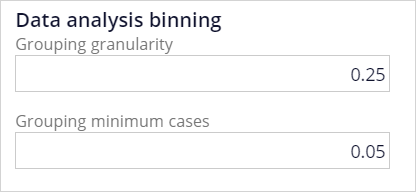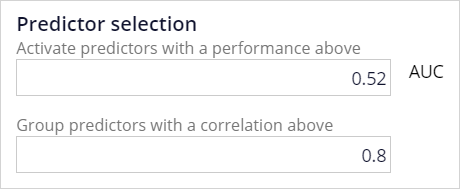
Advanced settings of an adaptive model
Default values
The default values for the adaptive model advanced settings are based on best practices and should only be changed by a highly experienced data scientist.
Update frequency and scope
When a model is updated, Prediction Studio re-trains the model with a specified number of responses. You can set the number of responses that will trigger the update.
You can also set the scope of the update. By default, all responses received during each update cycle are used. If you want to assign more weight to recent responses when updating a model, use a subset of the responses.
By default, all historical data is used to monitor the performance of the model. If required, model performance can be monitored for the most recent responses.
Grouping
The default values for Grouping granularity (the granularity of predictor binning) and Grouping minimum cases (the minimum percentage of cases per interval) are based on best practices and should not be changed casually.
The higher the value for Grouping granularity, the more bins are created. This value represents a statistical threshold that indicates when predictor bins with similar behavior are merged.
The Grouping minimum cases setting controls how predictor grouping is established. Higher values result in a decreasing number of groups, which can be used to increase the robustness of the model. Lower values result in an increasing number of groups, which can be used to increase the performance of the model.
The selection of the active predictors is guided by thresholds for predictor performance and the correlation between predictors.
The performance of a predictor is measured as the area under the curve (AUC). The minimum AUC value is 0.5, therefore the value of the performance threshold should always be set to at least 0.5. A higher threshold value results in fewer predictors in the final model.
The value for the correlation between predictors determines when predictors are considered similar, and only the best of those predictors are used for adaptive learning. The measure is the correlation between the probabilities of positive behavior within pairs of predictors.
This Topic is available in the following Modules:
If you are having problems with your training, please review the Pega Academy Support FAQs.
Want to help us improve this content?




